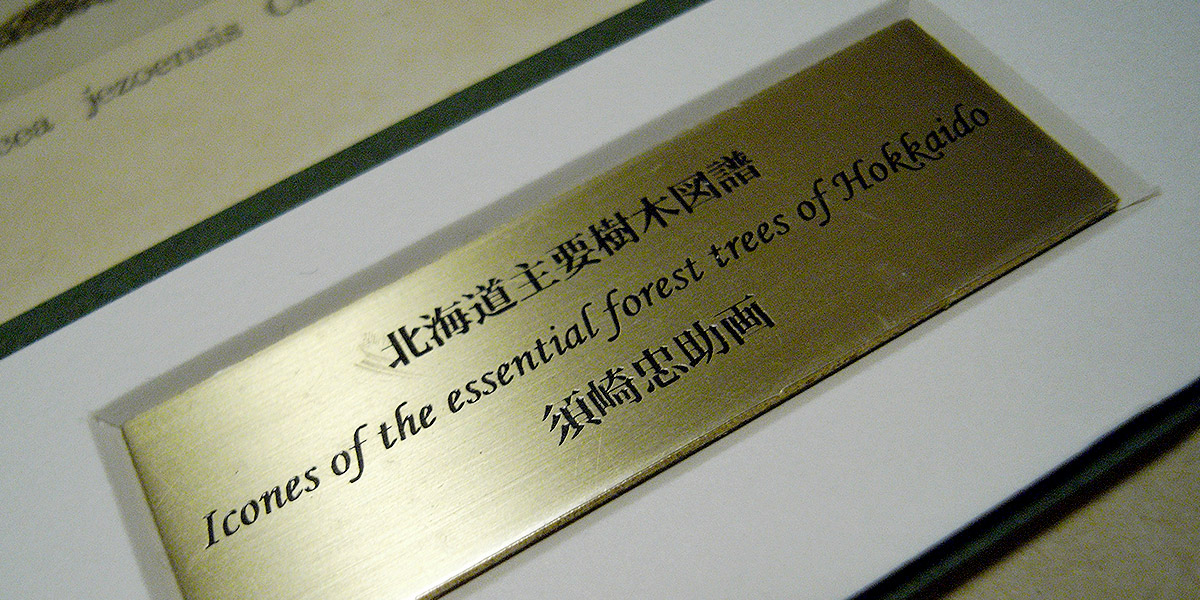Icones of the Essential Forest Trees of Hokkaido
In 1913, as demand for timber increased in industries such as paper manufacturing, housing, furniture production, and railway construction, the Hokkaido Government recognized the need to accumulate extensive knowledge about the region’s trees to meet these needs. Consequently, it commissioned Professor Kingo Miyabe of the School of Agriculture at Hokkaido University to compile a visual reference book containing detailed information on Hokkaido’s tree species.
At the time, Hokkaido still boasted vast, largely untouched primeval forests, making it a rich reservoir of timber. Professor Miyabe began the research and compilation with the assistance of Associate Professor Yushun Kudou and an artist named Tyusuke Suzaki. After eight years of preparation, the first issue was published in September 1920—exactly one hundred years ago.
The initial release featured detailed descriptions of four tree species, with bilingual captions in Japanese and English. These were accompanied by four precise, multi-colored lithographs that faithfully depicted not only the branches and leaves but also the fruit, flowers, buds, and roots. Subsequent issues were sent to subscribers every few months in large envelopes, each containing descriptions and lithographs of three additional tree species. In total, 28 mailings were delivered over twelve years until March 1931, ultimately introducing 85 different species and comprising 86 lithographs altogether.
Accordingly, Icones of the Essential Forest Trees of Hokkaido was not originally issued as a single bound volume, as we might expect today. Instead, it was published incrementally, reflecting the pace of ongoing research and artistic production. This method, common among art collections or other high-cost publications, meant that many recipients kept the individual issues sealed in their original envelopes for years. In some cases, these were scattered, lost, or damaged. Once the series was complete, however, some purchasers—prompted by the publisher—chose to bind the materials into a single book, while others divided them into three volumes or opted for traditional Japanese-style bindings. As a result, surviving copies today exist in various formats according to their owners’ preferences.
The publisher, Sanshusha (based in Kanda, Tokyo), was one of the leading printing firms of the time, equipped with state-of-the-art technology. Unfortunately, the company suffered devastating losses in both the Great Kanto Earthquake of 1923 and the Tokyo Air Raids of 1944, which destroyed all original drawings, lithographs, printing devices, and related materials.
As a result, historical materials related to Icones of the Essential Forest Trees of Hokkaido are now extremely scarce. A single lithograph plate could typically produce no more than about 300 prints, so it is estimated that no more than 300 complete sets were ever distributed. However, even this figure is uncertain due to the lack of definitive records.
Although the title specifies “Hokkaido,” the trees included in the collection are found widely throughout eastern Japan and are not limited to species native only to Hokkaido. The tree names are given in Japanese, English, and the Ainu language. At the time, photography was still in its infancy, and lenses lacked the resolution to capture fine botanical details. Film was also limited to black and white. As such, the most reliable method of documentation was through observation by the human eye and detailed hand-drawn illustrations.
To achieve this, specialized sketch artists known as ga-ko visited the forests repeatedly throughout the seasons, or they collected fruit and root samples for anatomical drawings in laboratories. The supervising professors maintained rigorous standards, guiding the artists to achieve the highest precision in detail and color accuracy.
The lithographs were printed on high-quality paper slightly larger than B4 size. The names of the original sketch artists and the lithograph technicians were noted in Roman characters in the margins—an unusual level of recognition for academic publications at the time. This suggests that the artists and craftsmen were held in high regard. They appear to have had access to a generous budget, allowing them to use high-grade French paints and top-tier paper. The Japanese dedication and national ambition to match global standards is almost palpable in the work, elevating its quality to a world-class level.
Today, the estimated 300 original copies of Icones of the Essential Forest Trees of Hokkaido can be found only in a handful of university and municipal libraries, as well as the National Diet Library. Reproducing such a publication in the same manner would be virtually impossible today, due to the extensive time, labor, and craftsmanship once required—skills that have largely disappeared in the wake of rapid technological advancement in printing. Therefore, we feel a profound responsibility to preserve and pass on these precious cultural assets to future generations

